Samsung QE55Q9FNA, QE65Q9FNA User manual

E-MANUAL
Thank you for purchasing this Samsung product. To receive more complete service, please register your product at
www.samsung.com
Model__________________ Serial No.__________________
To directly go to the page that provides instructions on how to use the manual for visually impaired users, select the Menu Learning Screen link below. “Menu Learning Screen” Link
Contents
Quick Guides
Connecting the Samsung Smart Remote to the TV
Using Smart Hub
Using the Ambient mode
10Screen states related to Ambient mode
11Changing the content and settings for Ambient mode
Using the Shortcuts
14 Adding channels
14 Moving channels
14 Removing a channels
Using Voice Interaction
15Running Voice Interaction
16Learning about Voice Command Guide
17Read Before Using Voice Interaction
Updating the TV’s Software
18 Updating the TV’s software to the latest version
18 Updating the TV automatically
Getting Support
19Getting support through Remote Management
20Finding the contact information for service
20 Requesting service
Connections
Connection Guide
Connecting an Antenna (Aerial)
Connecting to the Internet
23 Connecting to your Internet network
25 Checking the Internet connection status
25 Resetting Your Network
25Turning on the TV with a Mobile Device
25Connecting an IP control device to the TV
25Setting up an Internet connection over IPv6
26Changing the name of the TV on a network
Troubleshooting Internet Connectivity Issues
26 Troubleshooting Internet connectivity issues
Connecting Video Devices
28Connecting with an HDMI cable
29Connecting with a component cable (Only for models with COMPONENT IN / AV IN)
30Connecting with a composite cable (Only for models with COMPONENT IN / AV IN)
Audio Input and Output Connections
31 Connecting with an HDMI (ARC) cable
31Connecting with a digital audio (optical) cable
31Connecting through a wireless network
32Connecting Bluetooth Devices
Connecting a Computer
32 Connectingthroughthe HDMI port ― Screen Sharing (HDMI)
Connecting Your Mobile Device
33Connecting to the TV via the SmartThings app
34Bidirectionally mirroring your TV and mobile device using the SmartThings app
34 Managing a Mobile Device
Switching between external devices connected to the TV
35 Changing the input signal
35Editing the name and icon of an external device
36Using additional functions
Connection Notes
37Connection notes for HDMI
38Connection notes for audio devices
39Connection notes for computers
39 Connection notes for mobile devices
Remote Control and Peripherals
About the Samsung Smart Remote (QLED TV)
About the Samsung Smart Remote (UHD TV)
About the Samsung Smart Remote (THE FRAME)
Connecting the Samsung Smart Remote to the TV
Controlling External Devices with the Samsung Smart Remote - Using the Universal Remote
Using Anynet+ (HDMI-CEC)
51Connecting an external device through Anynet+ and using their menus
Controlling the TV with a Keyboard or Mouse
52 Connecting a USB keyboard or mouse
52Connecting a Bluetooth keyboard or mouse
53Using the keyboard and mouse
54Setting up the input devices
Entering Text using the On-Screen Virtual Keyboard
56Entering Text using the remote control's microphone and the on-screen Virtual keyboard
Smart Features
Smart Hub
58 Displaying the Home Screen
63 Launching Smart Hub automatically
63 Launching the last used app automatically
63 Testing Smart Hub connections
63 Resetting Smart Hub
Using a Samsung account
64Creating and managing your Samsung account
65Signing in to a Samsung account
Using the Ambient mode
Using the Apps Service
71Installing and running an app
72Managing purchased or installed apps
73Rating apps
Using the Gallery App
Using the Universal Guide App
Using the SmartThings App
Using the e-Manual
77Launching the e-Manual
78Using the buttons in the e-Manual
Using the Internet
Playing pictures/video/music
80 Playing media content
Using Voice Interaction
82Running Voice Interaction
83Learning about Voice Command Guide
84Read Before Using Voice Interaction
TV Viewing
Viewing Digital Broadcast Information at a Glance
85 Using the guide
Recording Programmes
87Recording programmes
88Managing the schedule recording list
89Viewing recorded programmes
89 Setting up a schedule recording start
Setting Up a Schedule Viewing
89Setting up a schedule viewing for a channel
90Editing a schedule viewing
67Screen states related to Ambient mode
68Changing the content and settings for Ambient mode
Using Timeshift
Buttons and functions available while recording a programme or Timeshift
Using the Channel List
Editing channels
94 Removing registered channels
94 Editing registered channels
Creating a Personal Favourites List
95 Registering channels as favourites
95 Viewing and selecting channels on Favourites lists only
Editing a Favourites List
96 Adding channels to favourites list
96 Removing channels from a favourites list
96 Rearranging a favourites list
96 Renaming a favourites list
TV-Viewing Support Functions
97Changing the broadcast signal
97Scanning for available channels
98Checking digital channel signal info and strength
98Restricting Viewing to Specific Channels
98Using Mark Adult Channels
98Selecting the broadcasting audio option
99Using Programme Rating Lock
99Configuring advanced broadcasting settings
99Reading digital text
100Selecting the broadcast audio language
100Tuning broadcast signals manually
101Fine-tuning analogue broadcasts
101 Transferring channel list
101Enabling/Disabling Edit Channel Numbers
101Deleting CAM operator profile
102Setting satellite system
102Changing teletext language
102Showing TVkey Interface menu
103Showing common interface menu
Picture and Sound
Adjusting the Picture Quality
104Choosing a picture mode
105Configuring advanced picture settings
Setting the Viewing Environment for External Devices
106Playing games on an optimised screen
107Configuring game mode details
108Viewing UHD videos
108 Using HDMI black level
Picture Support Functions
109Viewing a picture-in-picture (PIP)
109Changing the picture size
110Changing the picture size automatically
110 Changingthe picture size in 4:3 orScreen Fit mode
110 Fitting the picture to the screen
110 Adjusting the picture size and/or position
Configuring a Sound Mode and Expert Settings
111 Choosing a sound mode
111 Configuring advanced sound settings
Using the Sound Support Functions
112 Selecting speakers
112Listening to the TV through Bluetooth devices
113Listening to the TV through a Samsung audio device that supports the Wi-Fi function
System and Support
Using the Time Functions and the Timers
114Setting the current time
115Using the timers
Using the Auto Protection Time and Energy Saving Functions
116 Setting the Auto Protection Time
116 Reducing the energy consumption of the TV
Updating the TV’s Software
117 Updating the TV’s software to the latest version
117 Updating the TV automatically
Protecting the TV from Hacking and Malicious Code
118 Scanning the TV and connected storage for malicious code
Using Other Functions
118Running the accessibility functions
118Running Accessibility Shortcuts
119Enabling voice guides for the visually impaired
119Audio Description
120White text on black background (high contrast)
120Setting the screen to a black and white tone
120Inverting the screen colour
120Enlarging the font (for the visually impaired)
121Learning about the remote control (for the visually impaired)
121Learning about the TV menu
121Watching TV broadcasts with subtitles
122Listening to the TV through Bluetooth devices (for the hearing impaired)
122Configuring advanced system settings
123Restoring the TV to the factory settings
HbbTV
Using a TV Viewing Card (“CI or CI+ Card”)
125Connecting the “CI or CI+ Card” via COMMON INTERFACE slot with the CI CARD Adapter
126Connecting the “CI or CI+ Card” via COMMON INTERFACE slot
126Using the “CI or CI+ Card”
Teletext Feature
127 On the Samsung Smart Remote
129On the standard remote control
130Typical Teletext page
Troubleshooting
Getting Support
131Getting support through Remote Management
132Finding the contact information for service
133Requesting service
Diagnosing TV operational issues
There Is a Problem with the Picture
134 Testing the picture
I Can't Hear the Sound Clearly
137 Testing the sound
There Is a Problem with the Broadcast
My Computer / Game Console Won't Connect
The TV Won't Connect to the Internet
The Schedule Recording/Timeshift Function Isn't Working
Anynet+ (HDMI-CEC) Isn't Working
I Have Trouble Launching/Using Apps
My File Won't Play
I Want to Reset the TV
Other Issues
Precautions and Notes
Before Using the Recording and Timeshift Functions
145 Before using the recording and schedule recording functions
147 Before using the timeshift function
Supported broadcasting audio options
Read Before Using Apps
Read Before Using the Internet
150 Read before setting up a wireless Internet connection
Read Before Playing Photo, Video, or Music Files
151Limitations on use of photo, video, and music files
152Supported external subtitles
152Supported internal subtitles
153Supported image formats and resolutions
153Supported music formats and codecs
154Video codecs supported by Q900R model series
155Video codecs supported by NU7100 model series or higher
156Video codecs supported by NU7090 model series or lower
Read After Installing the TV
158Picture sizes and input signals
159Installing an anti-theft lock
Supported Resolutions for UHD Input Signals
159 If HDMI UHD Color is set to Off
159 If HDMI UHD Color is set to On
Resolutions for 8K Input Signals supported by Q900R model series
160 If HDMI UHD Color is set to On
Supported Resolutions for FreeSync
Read Before Connecting a Computer (Supported Resolutions)
161IBM
161MAC
162VESA DMT
163VESA CVT
163CTA-861
Supported Resolutions for Video Signals
164CTA-861
165VESA CVT
Read Before Using Bluetooth Devices
166 Restrictions on using Bluetooth
Buttons and functions available while playing multimedia content
Licence
Accessibility Guidance
Menu Learning Screen
Using the Remote control
171 Orientation of the Samsung Smart Remote
171 Description of the Samsung Smart Remote
Using the accessibility menu
173Accessibility Shortcuts menu
174Step by Step instructions to run the options
176 Setting accessibility settings using Voice Interaction
Using the TV with Voice Guide on
177 Watching TV
Using the guide
Setting Up a Schedule Viewing
182 Cancelling a scheduled viewing
Using the Channel List
185 Creating a Personal Favourites List
Recording
187Using the instant and schedule recording options from the guide screen:
188Using the Instant and Schedule Recording options from the programme info window
188Changing the recording time
189Viewing recorded programmes
189Deleting a recorded programme
Using Smart Hub
190Smart Hub
191Using the Home Screen in Smart Hub
Launching the e-Manual
Using Voice Interaction
196 Running Voice Interaction
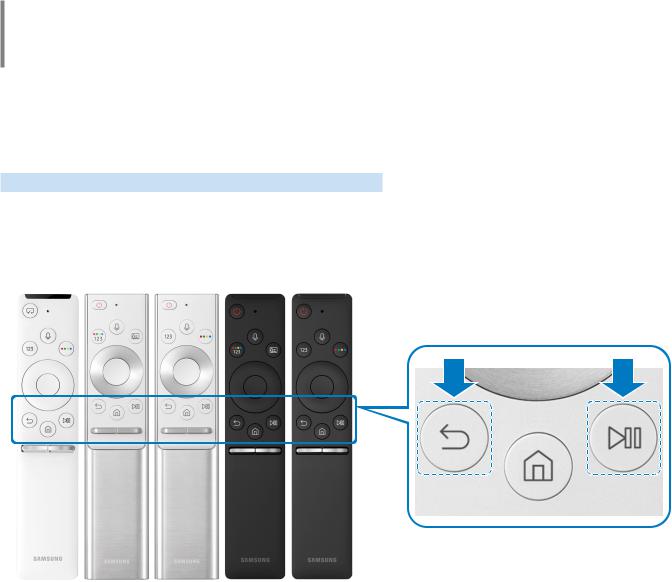
Quick Guides
You can learn quickly how to run and use the frequently used functions, such as Voice Interaction, Ambient mode, and Smart Hub.
Connecting the Samsung Smart Remote to the TV
Connect the Samsung Smart Remote to your TV to operate the TV.
When you turn on the TV for the first time, the Samsung Smart Remote pairs to the TV automatically. If the Samsung Smart Remote does not pair to the TV automatically, point it at the remote control sensor of the TV, and then press and hold the  and
and  buttons simultaneously for 3 seconds or more.
buttons simultaneously for 3 seconds or more.
"" The images, buttons, and functions of the Samsung Smart Remote may differ with the model.
"" For more information about the Samsung Smart Remote that comes with the QLED TV, refer to "About the Samsung Smart Remote (QLED TV)".
"" For more information about the Samsung Smart Remote that comes with the UHD TV, refer to "About the Samsung Smart Remote (UHD TV)".
"" For more information about the Samsung Smart Remote that comes with THE FRAME TV, refer to "About the Samsung Smart Remote (THE FRAME)".
"" The Samsung Smart Remote may not be supported depending on the model or geographical area.
- 7 -
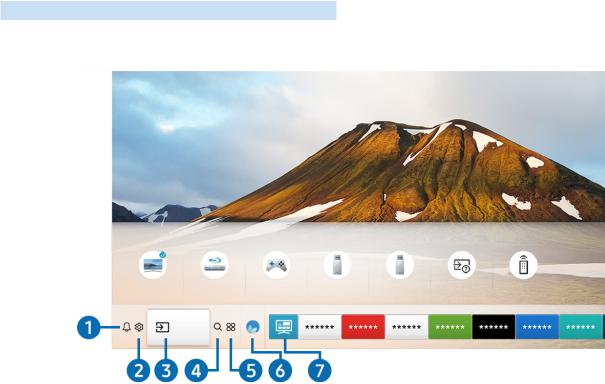
Using Smart Hub
Connect to Smart Hub for apps, games, movies, and more.
Enjoy the multiple functions provided by Smart Hub simultaneously on a single screen.
Sources
TV |
HDMI 1 |
HDMI 2 |
USB 1 |
USB 2 |
Connection |
Universal |
|
Guide |
Remote |
||||||
|
|
|
|
|
|||
|
Source |
|
|
|
|
|
"" The image on your TV may differ from the image above depending on the model and geographical area.
When you press the  button on your remote control, you can use the following functions and features.
button on your remote control, you can use the following functions and features.
1  Notification
Notification
You can view a list of notifications for all events that occur on your TV. A notification appears on the screen when it is time to broadcast a scheduled programme or when an event occurs on a registered device.
"" For more information, refer to "Displaying the Home Screen".
2  Settings
Settings
When the focus is moved to the icon, a list of quick settings icons appears above the top of the menu. You can quickly set frequently used functions by clicking the icons.
icon, a list of quick settings icons appears above the top of the menu. You can quickly set frequently used functions by clicking the icons.
3  Source
Source
You can select an external device connected to the TV.
"" For more information, refer to "Switching between external devices connected to the TV".
- 8 -

4  Search
Search
You can search for channels, programmes, movie titles, and apps from Smart Hub.
"" To use this feature, the TV must be connected to the Internet.
5  APPS
APPS
You can enjoy a wide range of content including news, sports, weather, and games by installing the corresponding apps on your TV.
"" To use this feature, the TV must be connected to the Internet.
"" For more information, refer to "Using the Apps Service".
6  Ambient mode
Ambient mode
In Ambient mode, you can view beautiful screens, various visual information, and notifications.
To enter Ambient mode, press the  button. To return to the TV mode, press the
button. To return to the TV mode, press the  button. To shut off the TV, press the
button. To shut off the TV, press the  button.
button.
If you press the  button when the TV is turned off, the TV turns on in Ambient mode.
button when the TV is turned off, the TV turns on in Ambient mode.
"" If you use a remote control other than the Samsung Smart Remote, there may be restrictions to entering Ambient mode.
"" Because this function is a QLED TV-specific function, it may not be supported depending on the model.
"" For more information about the Ambient mode, refer to "Using the Ambient mode".
7 Universal Guide
Universal Guide is an app that allows you to search for and enjoy various content such as TV shows, dramas, movies, and music in one place. Universal Guide can recommend content tailored to your preferences and notify you of new drama series.
"" For more information about the Universal Guide, refer to "Using the Universal Guide App".
"" Images may look blurry depending on the service provider's circumstances.
"" This function may not be supported depending on the model or geographical area.
 Art
Art
When you are not watching TV or when the TV is turned off, you can use the Art mode function to edit image content such as artworks or photos or to display the content.
"" This function is supported only in THE FRAME model.
"" For more information, refer to the provided user manual.
- 9 -

Using the Ambient mode
Learn about the functions available in Ambient mode, which is a QLED TV-specific function.

 Ambient mode
Ambient mode
In Ambient mode, you can view beautiful screens, various visual information, and notifications.
To enter Ambient mode, press |
button. To return to the TV mode, press |
button. To shut off the TV, |
||||
press |
button. |
|
|
|||
If you press |
button when the TV is turned off, the TV turns on in Ambient mode. |
|||||
"" |
If you use a remote control other than the Samsung Smart Remote, there may be restrictions to entering Ambient mode. |
|||||
"" Because this function is a QLED TV-specific function, it may not be supported depending on the model. |
||||||
"" |
To activate the |
|
|
menus, first select a content item in Ambient mode. |
|
|
|
|
|
||||
Screen states related to Ambient mode
●● Ambient mode
In Ambient mode, you can set up and enjoy visual information and design. In this state, less power is consumed and brightness is automatically adjusted by the illuminance sensor.
●● Getting dark state
In Ambient mode, the TV screen changes automatically according to the surroundings. When the surroundings get dark, the TV screen becomes darker. When the surroundings get bright before the TV screen turns completely black or when the remote control or the Voice Interaction function is operated, the TV screen returns to Ambient mode.
"" |
You can change the auto brightness setting for Ambient mode by using |
in the Ambient mode browser screen. |
"" |
In this state, the TV is ready to process voice guides and voice commands. |
|
●● Black screen state
In Ambient mode, if the surroundings get screen back on in Ambient mode, press
level of darkness, the TV turns soft-off. To turn the  button on the remote control.
button on the remote control.
"" |
You can change the auto brightness setting for Ambient mode by using |
in the Ambient mode browser screen. |
"" |
In this state, the TV cannot process voice guides and voice commands. |
|
- 10 -
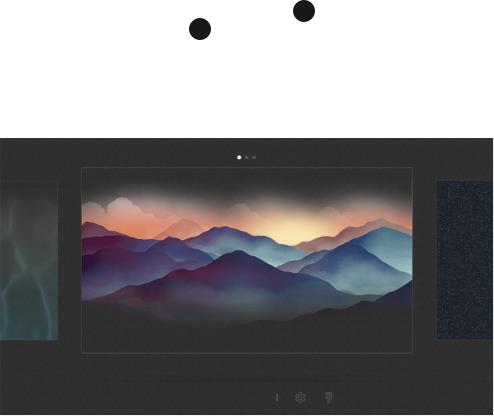
●● TV off state
To enter Ambient mode when the TV is turned off, press the  button on the remote control. To enter TV mode when the TV is turned off, press the
button on the remote control. To enter TV mode when the TV is turned off, press the  button. In TV mode, you can watch broadcasts or enjoy the content on the external devices connected.
button. In TV mode, you can watch broadcasts or enjoy the content on the external devices connected.
Changing the content and settings for Ambient mode
Décor Info Photo
"" The image on your TV may differ from the image above depending on the model and geographical area.
When you press the  or
or  button in Ambient mode, the Ambient mode browser screen appears. In the Ambient mode browser screen, you can select content and change the Ambient mode settings.
button in Ambient mode, the Ambient mode browser screen appears. In the Ambient mode browser screen, you can select content and change the Ambient mode settings.
Setting up the content for Ambient mode
The Ambient mode browser screen displays content at the top and categories at the bottom. Use the left or right directional buttons in the content list at the top to move the focus to content you want, and then press the Select button. The selected content is played in Ambient mode.
- 11 -
In the future, more content that you can set up in the Ambient mode browser will be provided.
You can select the following categories and content:
●● Décor: Provides beautiful screens.
●● Info: Provides information such as weather, news headlines, and more.
"" This function may not be supported depending on the geographical area.
●● Photo: Allows you to set a picture stored in your mobile device as the wallpaper of the Ambient mode screen. You can configure special layouts with your photos.
"" To save photos from your mobile device to the TV and import them in Ambient mode, use the SmartThings app on your mobile device.
Setting up the Ambient mode details
In the Ambient mode browser screen, move the focus to  , and then press the Select button. You can change the following settings:
, and then press the Select button. You can change the following settings:
●● Brightness: Adjust the screen brightness for Ambient mode.
●● Colour Tone: Adjust the colours of the screen for Ambient mode.
●● Auto Brightness: Change the auto brightness setting for Ambient mode.
"" When this function is set to Off, the brightness level of the TV screen is not automatically adjusted according to the ambient light level.
●● Ambient Off Timer: Set the time that the Ambient mode screen turns off automatically.
"" If there is no remote control input for the set time, the screen goes off. To turn the screen back on in Ambient mode, press the  button on the remote control.
button on the remote control.
Changing the background colour of Ambient mode
To change the background colour of Ambient mode, move the focus to  in the Ambient mode browser screen, and then press the Select button. You can change the background colour or pattern. Move the focus to a colour or pattern you want, and then press the Select button.
in the Ambient mode browser screen, and then press the Select button. You can change the background colour or pattern. Move the focus to a colour or pattern you want, and then press the Select button.
"" Take a picture of a wall using the SmartThings app on your mobile device to set it as the background of Ambient mode. This function may have a delay in image transmission and optimisation depending on the network conditions.
- 12 -
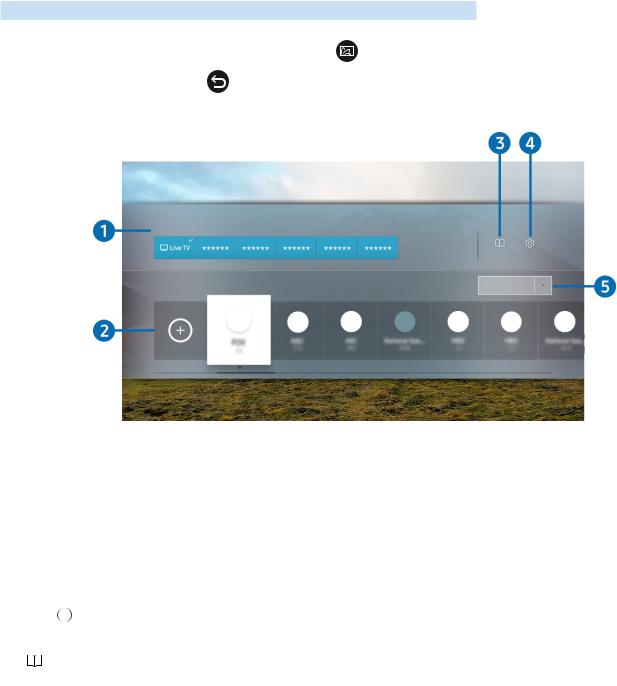
Using the Shortcuts
You can easily use the contents of Sources without running a series of commands.
To display the Shortcuts menu screen, press and hold |
button for1 second or more. |
|
To return to the TV mode, press |
button. |
|
"" Because this function is a QLED TV-specific function, it may not be supported depending on the model.
Shortcuts
Sources
e-Manual Settings
Terrestrial
Channels
"" The image on your TV may differ from the image above depending on the model and geographical area.
1 Sources
You can select an external device connected to the TV.
2 Channels
Press |
|
|
|
button to add a broadcast channel. You can move or remove added broadcast channels. |
|
|
|
e-Manual
Displays the e-Manual guide.
- 13 -
4  Settings
Settings
Displays the main on-screen menu.
5 Terrestrial, Cable, Satellite, or Service Provider
Choose the broadcast type of the content: Terrestrial, Cable, Satellite, or Service Provider.
"" This function may not be supported depending on the incoming broadcast signal.
Adding channels
1.Press  .
.
2.Move to the desired location.
3.Press the Select button.
The target channel is added in the bookmark area.
Moving channels
1.Move the focus to the channels to move.
2.Press the down directional button.
3.Select Move.
4.Move the selected channels to the desired location.
5.Press the Select button.
The selected channels is moved.
Removing a channels
1.Move the focus to the channels to remove.
2.Press the down directional button.
3.Select Remove.
The selected channels is removed.
- 14 -
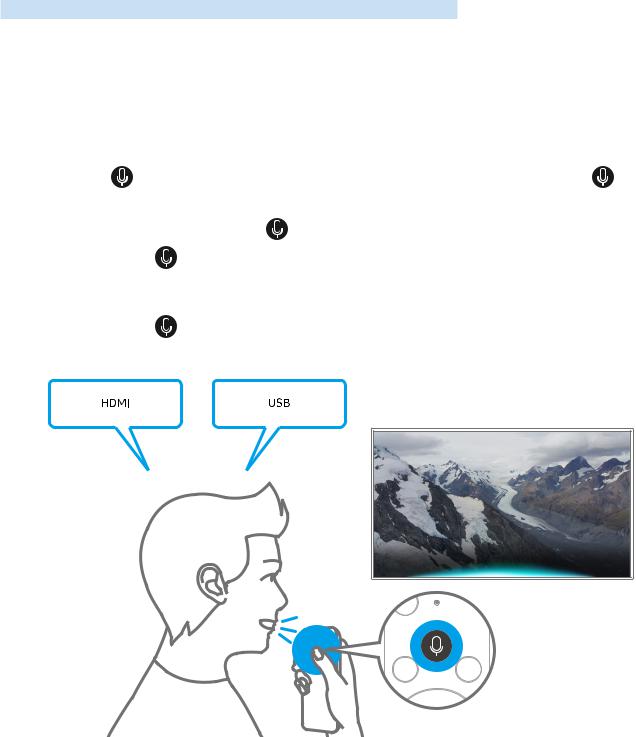
Using Voice Interaction
Speak into the microphone on your Samsung Smart Remote to control your TV.
"" This function may not be supported depending on the model or geographical area.
"" The supported language may differ depending on the geographical area.
Running Voice Interaction
Press and hold |
button on your Samsung Smart Remote, say a command, and then release |
button. |
||
The TV recognises the voice command. |
|
|
||
To view the Voice Interaction guide, press |
button once: |
|
||
●● |
When you press |
button for the first time, the Using Voice Interaction button appears at the bottom of |
||
|
the screen. Press the Select button. The Using Voice Interaction popup window appears and a tutorial on using |
|||
|
Voice Interaction is shown. |
|
|
|
●● |
When you press |
button, the Enter Voice Command Guide button appears at the bottom of the screen. |
||
Press the Select button to go to the Voice Command Guide screen.
- 15 -

Learning about Voice Command Guide
Voice Command Guide
Here are some of the things I can do for you.
"" The image on your TV may differ from the image above depending on the model and geographical area.
1 Voice Command Guide
You can learn the voice commands to use the Voice Interaction in various situations. Use the directional buttons to move to the desired command, and then press the Select button. You can operate the TV with various voice commands.
"" To view a tutorial on Voice Interaction, use the directional buttons to move to the bottom, and then select the View Tutorial item.
- 16 -

Read Before Using Voice Interaction
Precautions for Voice Interaction
●● The supported voice interaction languages and features may differ depending on the geographical area.
●● If the language set differs from the language of your country, some features are not available.
●● Voice Interaction is available only when the TV is connected to the Internet.
●● Even if the TV is connected to the Internet, there may be no response due to a Voice Interaction server error.
●● The existing functional specifications may be changed if Voice Interaction is updated.
●● Voice Interaction is available only on TVs that support it and come with remote controls that have a microphone.
●● Symbols including "-" and special characters are not supported. Consequently, if a word or sentence contains numeric values or symbols, the function may not operate properly.
●● Searched results may not provide complete results.
●● You may be required to pay for some apps. Consequently, you may encounter a service application or contract.
●● To change the current channel by saying channel names as voice commands, you must finish Set Up Your Service Provider. If Set Up Your Service Provider is not completed, you can complete it using the following menu.
– |
|
Settings General Start Setup Try Now |
|
●● To use the voice text input function and Smart search function, you must consent to provisions allowing third parties to collect and use your voice data.
●● To use the Voice Interaction function, you must:
–– Agree to Smart Hub's Terms of Use
–– Agree to a guidance regarding the collection and use of personal information for the Smart Hub service.
–– Consent to the collection and use of personal information for the voice interaction-based service.
Requirements for using Voice Interaction
●● The voice interaction rate differs with the volume/tone, pronunciation, and ambient sound environment (TV sound and ambient noise).
●● The optimal volume for voice commands is between 75 dB and 80 dB.
- 17 -

Updating the TV’s Software
View your TV's software version and update it if necessary.
 Settings Support Software Update Try Now
Settings Support Software Update Try Now
Updating the TV’s software to the latest version
[[ DO NOT turn off the TV’s power until the update is complete. The TV will turn off and on automatically after completing the software update. Video and audio settings will be reset to their defaults after a software update.
Updating through the Internet
 Settings Support Software Update Update Now Try Now
Settings Support Software Update Update Now Try Now
"" Updating from the Internet requires an active Internet connection.
Updating through a USB device
Settings Support Software Update Update Now
After downloading the update file from the Samsung website and storing it on a USB device, connect the USB device to the TV to update.
"" To update using a USB flash drive, download the update package from Samsung.com to your computer. Then, save the update package in the USB device's top-level folder. Otherwise, the TV will not be able to locate the update package.
Updating the TV automatically
Settings Support Software Update Auto update Try Now
If the TV is connected to the Internet, you can have the TV update its software automatically while you are watching the TV. When the background update is completed, it is applied the next time the TV is turned on.
If you agree to the Smart Hub terms and conditions, Auto update is set to On automatically. If you want this function disabled, use the Select button to turn it off.
"" This function may take a longer time if another network function is running concurrently.
"" This function requires an Internet connection.
- 18 -

Getting Support
Get help directly from Samsung if you have a problem with your TV.
Getting support through Remote Management
Settings Support Remote Management Try Now
After consenting to our service agreement, you can use Remote Management to access Remote Support and have a Samsung service technician diagnose your TV, correct problems, and update your TV's software remotely via the web. You can also turn Remote Management on and off.
"" This function requires an Internet connection.
"" You can also start this function by pressing and holding |
button for 5 or more seconds. |
What is Remote Support?
Samsung Remote Support service offers you one-on-one support with a Samsung Technician who can remotely:
●● Diagnose your TV
●● Adjust the TV settings for you
●● Perform a factory reset on your TV
●● Install recommended firmware updates
How does Remote Support Work?
You can easily get Samsung Remote Support service for your TV:
1.
2.
Call the Samsung Contact Centre and ask for remote support.
Open the menu on your TV and go to the Support section |
|
Settings Support) |
|
3.Select Remote Management, then read and agree to the service agreements. When the PIN screen appears, provide the PIN number to the technician.
4.The technician will then access your TV.
- 19 -

Finding the contact information for service
Settings Support About This TV Try Now
You can view the address of the Samsung website, the call centre phone number, your TV's model number, your TV's software version, Open Source Licence and other information you may need to get service support from a Samsung call agent or the Samsung website.
"" You can also view information by scanning the QR code of your TV.
"" You can also start this function by pressing and holding |
button for 5 or more seconds. For standard remote control, |
|
press and hold the |
(Play) button for 5 or more seconds. Continue holding the button until the customer information |
|
pop-up window appears. |
|
|
Requesting service
Settings Support Request Support Try Now
You can request service when you encounter a problem with the TV. Select the item matching the problem that you encountered, and then select Request Now or Schedule Appointment Send. Your service request will be registered. The Samsung Contact Centre will contact you to set up or confirm your service appointment.
"" This function may not be supported depending on the geographical area.
"" You must agree to the terms and conditions for the service request.
"" This function requires an Internet connection.
- 20 -

Connections
You can watch live broadcasts by connecting an antenna and antenna cable to your TV and can get access to the Internet by using a LAN cable or wireless router. Using various connectors, you can also connect external devices.
Connection Guide
You can view detailed information about external devices that can be connected to the TV.
Source Connection Guide
It guides you the way to connect various external devices such as the cable box, game console, and PC through pictures. If you select the connection method to an external device, the information details appear.
Connection Guide
Cable Box/Disc Player |
HDMI |
Game Console
PC
Audio device
Mobile Device
External Storage
Accessory
"" The image on your TV may differ from the image above depending on the model and geographical area.
- 21 -
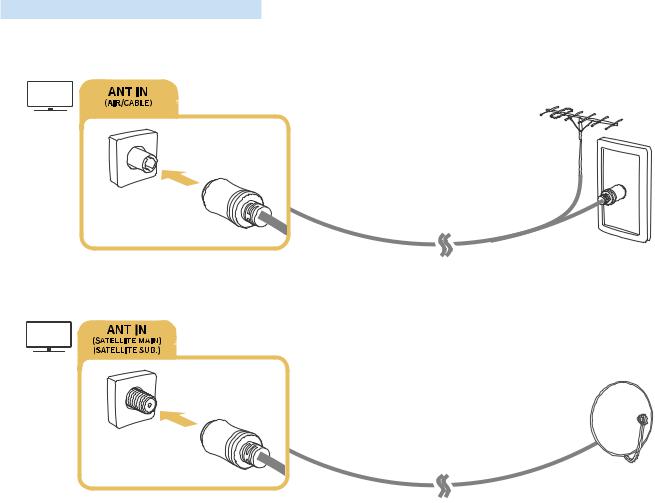
Connecting an Antenna (Aerial)
You can connect an antenna cable to your TV.
"" An antenna connection is not necessary if you connect a cable box or satellite box.
It is best to connect the both connectors using a Multi-Switch or DiSEqC. Switch, etc and to set Aerial Connection Type to Dual Oscillator.
"" A connection method may differ with the models.
"" The DVB-T2 system may not be supported depending on the geographical area.
"" Depending on the model or geographical area.
- 22 -
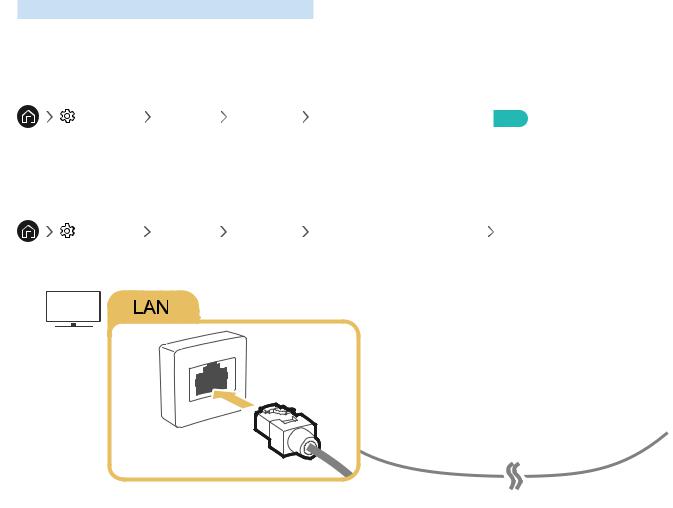
Connecting to the Internet
You can get access to the Internet through your TV.
Connecting to your Internet network
Settings General Network Open Network Settings Try Now
Connect to an available network.
Establishing a wired Internet connection
Settings General Network Open Network Settings Wired
If you connect a LAN cable, the TV automatically accesses the Internet.
"" Use a CAT 7 (*STP type) cable for the connection. * Shielded Twist Pair
"" The TV will not be able to connect to the Internet if your network speed is below 10 Mbps.
- 23 -
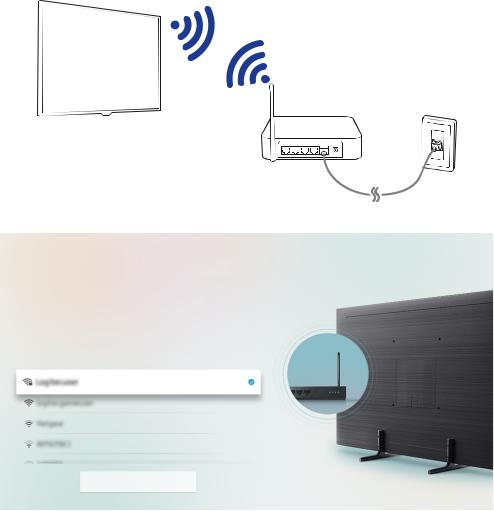
Establishing a wireless Internet connection


 Settings
Settings  General
General  Network
Network  Open Network Settings
Open Network Settings  Wireless
Wireless
Make sure that you have the wireless router's SSID (name) and password settings before attempting to connect, and then follow the directions on the screen.
Wireless Connection
Select your wireless network.
Refresh
"" The image on your TV may differ from the image above depending on the model and geographical area.
"" If no wireless router is found, select Add Network at the bottom of the list and enter the network name (SSID).
"" If your wireless router has a WPS or PBC button, select Use WPS at the bottom of the list, and then push the WPS or PBC button on your router within 2 minutes. The TV will connect automatically.
- 24 -

Checking the Internet connection status
Settings General Network Network Status Try Now
View the current network and Internet status.
Resetting Your Network
Settings General Network Reset Network Try Now
Restore the network settings to the factory defaults.
Turning on the TV with a Mobile Device
Settings General Network Expert Settings Power On with Mobile
You can turn on the TV with your mobile device when both of them are connected to the same network.
Connecting an IP control device to the TV
Settings General Network Expert Settings IP Remote
You can connect an IP control device to the TV remotely to manage your IP device.
""
""
""
Setting up an Internet connection over IPv6
Configuring the IPv6 connection settings
Settings General Network Expert Settings IPv6
"" This function may not be supported depending on the model or geographical area.
- 25 -

Checking an Internet connection set up over IPv6
Settings General Network Expert Settings IPv6 Status
"" This function may not be supported depending on the model or geographical area.
Changing the name of the TV on a network
Settings General System Manager Device Name Try Now
You can change the name of the TV on the network. Select User Input at the bottom of the list and change the name.
Troubleshooting Internet Connectivity Issues
If your TV won't connect to the Internet, try the solutions below.
Troubleshooting Internet connectivity issues Try Now
After reading the following content, troubleshoot the Internet connection issue. If the problem persists, contact your Internet Service Provider.
No network cable found
Make sure that the LAN cable is plugged in on both ends. If it is plugged in, make sure that the router is turned on. If the router is on, try turning it off and then on.
Wireless network connection failed
If a selected wireless router is not found, go to Open Network Settings, and then select the correct router.
– |
|
Settings General Network Open Network Settings |
|
- 26 -

Unable to connect to a wireless router
1.Check if the router is turned on. If it is, turn it off and then on.
2.Enter the correct password if required.
IP auto setting failed
1.Configure the settings in IP Settings.
–– |
Settings General Network Network Status IP Settings |
2.Make sure that the DHCP server is enabled on the router, and then unplug the router and plug it back in.
3.Reset the router if required.
–– For wireless connection, enter the correct password if required.
Unable to connect to the network
1.Check all IP Settings.
–– |
Settings General Network Network Status IP Settings |
2.After checking the DHCP server status (must be active) on the router, remove the LAN cable, and then connect it again.
–– For wireless connection, enter the correct password if required.
Connected to a local network, but not to the Internet
1.Make sure that the Internet LAN cable is connected to the router's external LAN port.
2.Check the DNS values in IP Settings.
–– |
Settings General Network Network Status IP Settings |
Network setup is complete, but unable to connect to the Internet
If the problem persists, contact your Internet Service Provider.
- 27 -
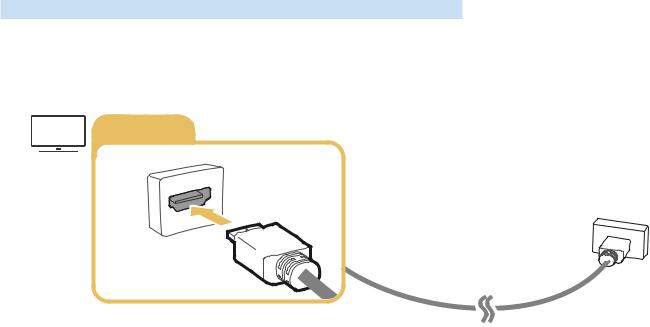
Connecting Video Devices
Make the correct video connections between your TV and your external devices.
Connecting with an HDMI cable
HDMI IN
- 28 -
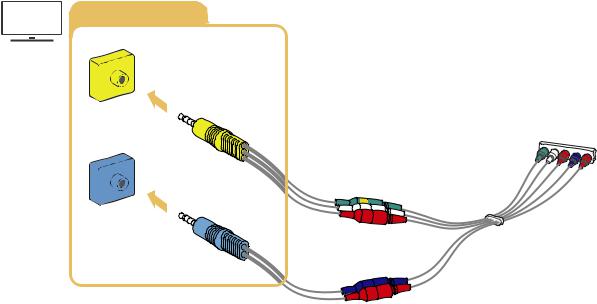
Connecting with a component cable (Only for models with COMPONENT IN / AV IN)
A Component connection lets you enjoy video resolutions up to 1080p. To watch video from most DVD and Blu-ray players, use the Component connection.
Review the illustration below, and then connect Component IN and AV IN on the TV to Component OUT on the external device by using the provided component and AV adaptors. Make sure to connect the same colour connectors together. (blue to blue, yellow to yellow, etc.)
COMPONENT IN / AV IN
AV IN
COMPONENT IN
"" To use component equipment, connect both the component adapter (blue) and the AV adapter (yellow).
- 29 -
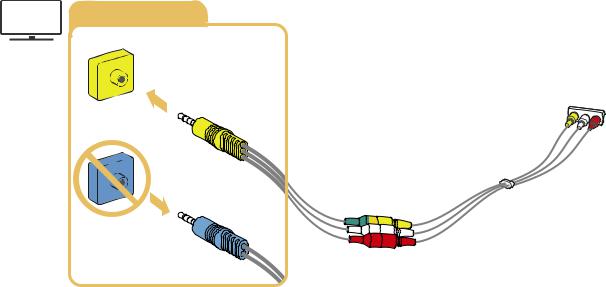
Connecting with a composite cable (Only for models with COMPONENT IN / AV IN)
Through the AV connection, you can enjoy the resolution up to 576i.
Review the illustration below, and then connect AV IN on the TV to AV OUT on the external device using the provided AV adapter and composite cable. When connecting the cables, be sure to match the colours of the cables to the colours of the ports.
COMPONENT IN / AV IN
AV IN
COMPONENT IN
"" Connect AV (composite) equipment to AV In only. Do not connect to Component In.
- 30 -
